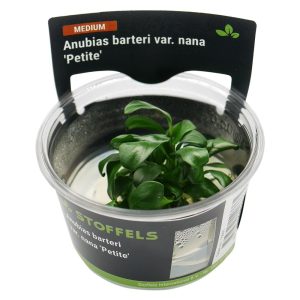No Products in the Cart

Flexible interest-free payment options available at checkout.
From as little as R 74.99 per payment. Learn more
The Anubias barteri ‘Petite’ is a highly popular, low-maintenance aquatic plant featuring small, dark green leaves and compact growth. Renowned for its hardiness, it is perfect for both beginner and experienced aquarists. The in-vitro version ensures a healthy, pest-free plant, ideal for immediate introduction into your aquarium.
Compact Size: Smaller than the standard Anubias barteri, making it ideal for nano aquariums or as an accent plant in foreground or midground areas.
Hardy Plant: Tolerates a wide range of water conditions and thrives in low to moderate lighting.
In-Vitro Cultivation: Grown in sterile, nutrient-rich conditions, free from snails, algae, and pathogens for a clean start.
Low Maintenance: Slow-growing and requires minimal trimming, making it perfect for low-tech setups or tanks without CO₂ supplementation.
Lighting: Tolerates low light but also thrives under moderate lighting. Avoid high-intensity direct light to prevent algae on leaves.
CO₂: Not required, but can enhance growth and overall plant health.
Water Parameters: pH 6.0–7.5 | Temperature 22–28 °C
Placement: Best in the foreground or attached to hardscape such as driftwood or rocks. Avoid burying the rhizome to prevent rot.
Growth Rate: Slow; encourages compact, tidy growth.
Propagation: Rhizome division.
Rinse the plant thoroughly to remove nutrient gel before planting.
Can be tied or glued to hardscape (driftwood, rocks, decorative stones).
Can also be placed on the substrate, but ensure the rhizome remains above it to avoid decay.
Its slow growth makes it ideal for low-maintenance aquariums and aquascapes.
Scientific Name: Anubias barteri ‘Petite’
Origin: West Africa
Family: Araceae
Height: 3–5 cm
Growth Rate: Slow
Placement in Tank: Foreground, Midground, Attached to Hardscape
Light Requirement: Low to Moderate
CO₂ Requirement: Not necessary but can enhance growth
Temperature: 22–28 °C
pH: 6.0–7.5
Propagation: Rhizome division



